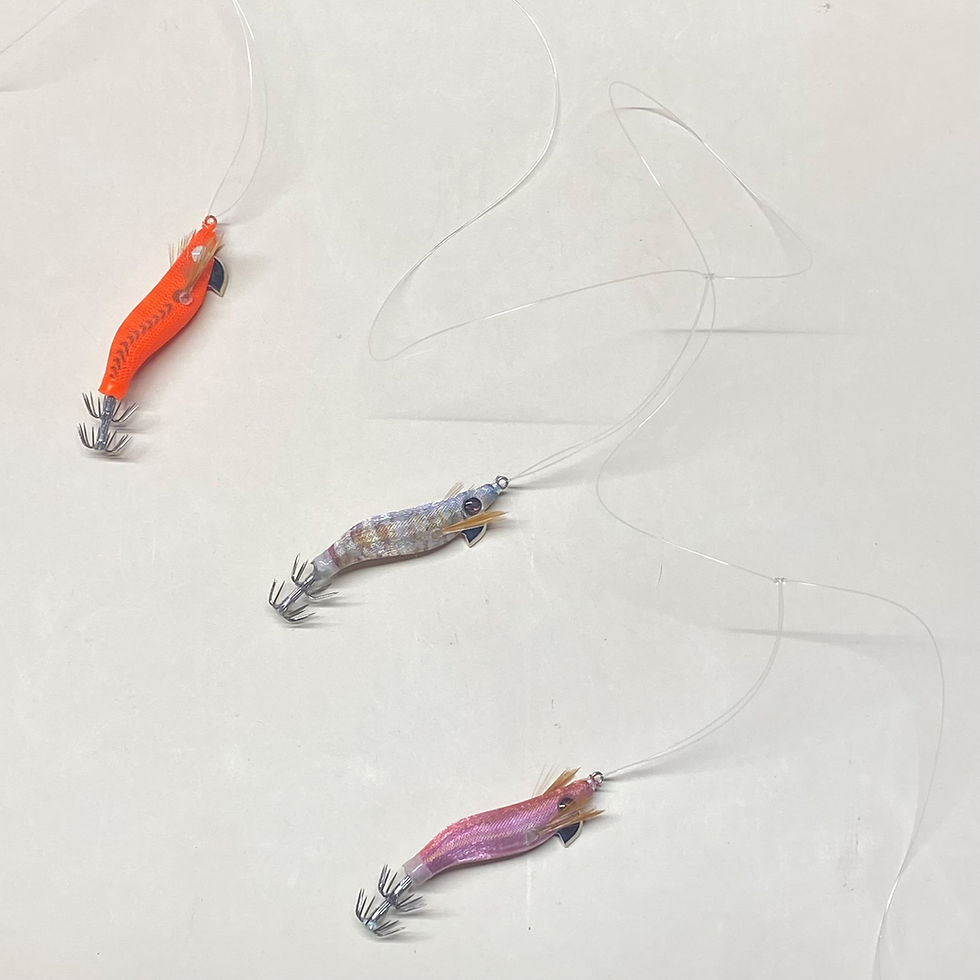2025 Squid Season Approaches: Gear, Tips, and Tactics
- Eddy Kooyomjian

- Apr 5
- 8 min read

One of the truly remarkable things about the fishing in New England is the variety of species that pass through and are available to anglers in a relatively small area. As the winter transitions to spring and the waters slowly warm, many species come inshore in shallower waters to spawn. The options increase seemingly each passing week.
After a long winter, I am eager to get outside and also plan activities for myself to relieve some of the cabin fever. I'm also trying to get my young children away from a set of gaming controls or screen. The objectives are simple. Get outside, breath in some spring salt air, and find something to bend the rod.
Enter the Squid. Squid fishing checks off a lot of boxes for early season.
DURATION: A trip chasing squid can be a relatively short adventure compared to other fishing trips taken later in the season.
ENTERTAINMENT: Squid fishing can be fast paced and attention grabbing. During the height of the squid centric part of the season, boats are generally fishing closer together and the action all around can be very entertaining.
SQUID BIOLOGY: I don't know many children, or adults for that matter, who don't find squid fun and interesting. Everything from, the tentacles, to the eyes, to the changing coloration, and of course the ink, are fascinating and educational.
LOW KEY/LOW STRESS: As far as objectives and expectations are concerned, a trip for squid is low stakes, Filling a bucket or cooler with squid can be satisfying without being stressful or competitive while doing it.
FINDING SQUID ON CAPE COD

When spawning in the early spring, the biomass of squid can be quite concentrated and the congregation of a fleet of boats can easily give this away. Fishing in a fleet is perhaps a good way to start an exploration, but if you have fished for squid before and are looking for your own water, simply drifting over a known area of structure can reveal some squiggly blue lines on your sonar that may indicate their presence. The structure part is important because the squid like to spawn and lay their eggs along this structure.
A few drifts to locate the concentration of squid could lead to a decision to anchor if the drift is moderate or fast. Remember to be respectful of others that may be around you. If everyone is anchored, be careful drifting. If it seems like the vast majority of people are drifting in slower current, be mindful or move to your own area to anchor in a safe spot. It's important to be 'agile' and flexible. Be prepared to relocate or to lift an anchor and relocate. A squid bite can last long through a drift or be short lived and require a relocation.
I wonder about and am asked about tide. Like a lot of other species that we fish for, the appetites of the squid and an ability to present lures to them can be dependent on tide. At slack tide, its common that the bite completely shuts down until the water begins moving again. These situation may require a complete move or if you are determined to stay, you can try putting a single slow sinking jig on the line and cast it away from the boat as you might a bucktail and slowly work the lure up and down slowly back towards you, working the water column, but also giving the jig moving along the bottom that would normally be provided by current or drifting.
WORKING THE JIGS
Drop your rig slowly all the way to the bottom, being careful not to tangle the jigs. You want to slowly lift the rod tip and work the jigs up slowly. Remember that the squid jigs have an inherent buoyancy to them. The action of the jig in the current can often times entice the squid to explore and take the jig. You almost have to imagine that your slowly presenting the jigs horizontally in front of the squid and lifting only to tease them.
If you see or feel that the squid are off the bottom, you can slowly jig and reel in order to work the rig through the water column and get into the strike zone where the squid may be hanging. The soft tip or parabolic rods can really help with this.
The video below from Ryan Collins of MyFishingCapeCod provides a great sense of how squid attacks suspending/buoyant jigs. The first minute of the video shows the manner in which the squids reach out and grab the lure and draw it in towards them. You can see the squid extended two long tentacles in front of its others and attempting to grab and pull the lure towards it.
When the squid takes the jig, the feeling is not the standard 'tap' or 'strike' of a fish. The jig almost feel stuck in position and you will feel some resistance in the rod tip. At this point you have to suppress the instinct to 'set' the hook. The hooks on the squid jigs are tines that the squid is 'sticking' to. There are no barbs to pierce. Slowly reel the squid up towards the surface and this point, there's the critical point of the squid and the favorite part of the whole deal, INK !!
Ink and getting your boat dirty is part of a successful day of squid fishing. It's the part of squid fishing my children love and enjoy witnessing the most. Generally, I will allow the squid to discharge the ink in the water, before I lift the squid up and put it directly into a bucket to allow any subsequent inking to happen. Many folks will simply allow the squid to discharge ink in the water and then lift and utilize the jig itself as a handle to lift the tines up and drop the squid into a bucket or cooler.
SQUID FISHING TECHNIQUE AND 'THE BITE'
Drop jig to bottom and slowly lift and mix up your presentation by slowly retrieving your rig to the surface and then letting it back down. It's very likely that the squid are congregated on the bottom, but you may find yourself fishing a wider vertical portion of the water column.
Try To Avoid setting the hook!!! there are no barbs and the squid has very soft tissue.
Once being hooked up, bring squid to surface, keep tension and let it ink out.
Once the squid has squirted its ink out in one or two shots, swing the squid into your boat, kayak, or area keeping squid pointed away from face. If you end up lifting the squid without it relesing its ink, I will drop the squid into an empty buckt and allow it to release its ink into the bucket before I reach in and retrieve my jig.
Flip jig drop squid into holding bucket.
The bite is not so much of a bite as it is a pull. Hooking a squid will feel initially as though your rig and jig are stuck. The squid has wrapped its tentacle(s) around your jig and is looking to pull it down or to pull away from the rig.
It is very easy to tear away the jig tines from the tentacles so care should be taken not to pull too hard or to reel too quickly. Getting the squid to the surface requires steady pressure and a moderate to slow reel up.
SQUID FISHING OUTFITS
The simpler, the better. Anything basic that fits the description of 'light' tackle or even fresh water gear works. A 7' rod and 3000 class real is more than enough. Something with a soft tip or a parabolic action may suit you well in order to prevent the hooks of your squid jigs from pulling out of the soft flesh and tentacles of the squid. Main leader and leader can also be scaled down. Squid are known to have keen eyesight. Later in the article, there are some points about not setting the hook, but just know that the squid are not hard fighting and the chance of breakage from a strike is minimal. Of course you could get hung up, but that's a different problem.
LURES AND RIGS

Squid can be picky when it comes to size and colors of your jigs. It's important to be prepared with a variety of sizes and colors. I am still learning in this area, but in my own research and watching other I have been able to come with some general principals I try to keep in mind.
Pink is perhaps the 'best' and most popular color if you can only have one, but there are some close alternates, namely Ambers/Orange, Green, Blues, and Glow finishes. In terms of size, I would have someone fish a smaller sized jig and someone fish a larger jig and then see which produces better that day and swap over. There are those that will mix two sizes on one rig and that is ok too.

The basic rig consists of a two dropper 'High-Low' rig. Because squid jigs are buoyant and can float up or down in current, its critical that your rig have dropper loops that take into account the length of your jig and keep the hooks of your squid jigs completely apart to prevent tangling of the jigs. I use a two dropper rig for larger squid jigs which in this case is +/- a 4" jig. There is a loop at the end of the rig for a weight or a third weighted jig.

At any point you can cut one of the droppers to get a single dropper setup with a bottom loop if you desire. I personally T-knot these, mainly to allow the maximum buoyancy and action on the jig. I use a small clip to easily change jigs. If you tie your own rigs this is not at all necessary. Dropper loops work. This is personal preference.

I also implement a three hook, sabiki style rig that has three smaller squid jigs. For these I implement just a dropper loop. The small size jigs are 3" or less. It's very simply to tie your own and loop on your own jigs. Again just be really mindful of the distance between dropper loops.


Squid are delicious as table fare. They are also fantastic as a bait for other spring and summer bottom fishing species you may chase. Many of the squid caught end up in smaller freezer bags put away for another time and having 'native' squid as a bait can sometimes be the difference between catching and not catching those summer fluke. Two different video within this blog reference recipes for squid. The MFCC video featuring Ryan at his desk has a segment towards the end of the video where Ryan and his wife, Lauren, prepare squid and cook it. At the very bottom of this blog is a video from OnTheWater magazine. Towards the back end of the YouTube video is a segment from Andy Nabreski showing how he prepares and cooks squid to enjoy.
Summary
Fishing for squid can be a great entry back into your fishing and is a tremendous group activity with your kids or other friends and family. It's simple, low stress, relatively low tech. The most complicated part of your trip may be cleaning your boat afterwards. Hopefully the end result is a bucket of tasty calamari tubes for the table or for bait later in the season. Thank you for reading and I'm really looking forward to the 2024 season.
PRODUCTS REFERENCED IN THIS BLOG
Other Resources



















Comments